Influencing Factors of Consumers’ Impulse Purchase Intentions in Livestream E-Commerce Based on DEMATEL-AISM
Abstract
1. Introduction
2. Literature Review
2.1. The Theoretical Development and Influencing Factors of Consumer Impulse Purchase
2.2. The Research Framework of Influencing Factors in Livestream E-Commerce
2.3. Summary of Research Gaps
3. Methods
3.1. DEMATEL
3.1.1. Construct Direct Influence Matrix O
3.1.2. Normalized Influence Matrix N Based on Maximum Row Sum Normalization
3.1.3. Calculate Total Influence Matrix T
3.1.4. Calculate Influencing Degree, Influenced Degree, Centrality and Causality
3.1.5. Draw the Causality-Centrality Plot
3.2. AISM
3.2.1. From Adjacency Matrix A with the -Intercept to Holistic Adjacency Matrix Z
3.2.2. Calculate Reachable Matrix R
3.2.3. Factor Hierarchy Extraction
3.2.4. Calculate General Skeleton Matrix S′
| Algorithm 1 Factor hierarchy extraction and general skeleton matrix calculation |
Require: Reachability matrix R (size ) Ensure: Hierarchical levels and General Skeleton Matrix Step 1: Compute Reachable Set, Cause Set, and Common Set
Step 2: Factor Hierarchy Extraction
Step 3: Node Reduction (Merging Strongly Connected Factors)
Step 4: Remove Skip-Level Reachability
Step 5: Remove Self-Reachability
|
3.2.5. Draw the Adversarial Topological Hierarchy Diagrams
4. Results
4.1. Identify Influencing Factors and Construct Direct Influence Matrix
4.2. Influencing Degree, Influenced Degree, Centrality and Causality
4.3. Intercept and Reachable Matrix R
4.4. General Skeleton Matrix S′ and Antagonistic Topological Hierarchy
4.5. Sensitivity Analysis
5. Discussion
5.1. Analysis of Centrality and Causality
5.2. Analysis of Strong Connection Factors
5.3. Hierarchical and Causal Analysis
6. Conclusions
Author Contributions
Funding
Institutional Review Board Statement
Informed Consent Statement
Data Availability Statement
Conflicts of Interest
References
- Huang, Z.; Yan, X.; Deng, J. How Social Presence Influences Consumer Well-Being in Live Video Commerce: The Mediating Role of Shopping Enjoyment and the Moderating Role of Familiarity. J. Theor. Appl. Electron. Commer. Res. 2024, 19, 725–742. [Google Scholar] [CrossRef]
- Peng, Y.; Wang, Y.; Li, J.; Yang, Q. Impact of AI-Oriented Live-Streaming E-Commerce Service Failures on Consumer Disengagement—Empirical Evidence from China. J. Theor. Appl. Electron. Commer. Res. 2024, 19, 1580–1598. [Google Scholar] [CrossRef]
- Mutambik, I. The Emerging Phenomenon of Shopstreaming: Gaining a More Nuanced Understanding of the Factors Which Drive It. J. Theor. Appl. Electron. Commer. Res. 2024, 19, 2522–2542. [Google Scholar] [CrossRef]
- Cui, X.; Li, Y.; Li, X.; Fang, S. Livestream e-commerce in a platform supply chain: A product-fit uncertainty reduction perspective. Int. J. Prod. Econ. 2023, 258, 108796. [Google Scholar] [CrossRef]
- China Internet Network Information Center (CNNIC). The 53rd Statistical Report on the Development of the Internet in China released. Media Forum 2024, 7, 50. [Google Scholar]
- Li, G.; Cao, Y.; Lu, B.; Yu, Y.; Liu, H. Luxury brands’ live streaming sales: The roles of streamer identity and level strategy. Int. J. Advert. 2023, 42, 1178–1200. [Google Scholar] [CrossRef]
- Liu, D.; Yu, J. Impact of perceived diagnosticity on live streams and consumer purchase intention: Streamer type, product type, and brand awareness as moderators. Inf. Technol. Manag. 2024, 25, 219–232. [Google Scholar] [CrossRef]
- Yang, L.; Zheng, C.; Hao, C. Optimal platform sales mode in live streaming commerce supply chains. Electron. Commer. Res. 2024, 24, 1017–1070. [Google Scholar] [CrossRef]
- Hao, C.; Yang, L. Resale or agency sale? Equilibrium analysis on the role of live streaming selling. Eur. J. Oper. Res. 2023, 307, 1117–1134. [Google Scholar] [CrossRef]
- Kimiagari, S.; Malafe, N.S.A. The role of cognitive and affective responses in the relationship between internal and external stimuli on online impulse buying behavior. J. Retail. Consum. Serv. 2021, 61, 102567. [Google Scholar] [CrossRef]
- Zafar, A.U.; Qiu, J.; Li, Y.; Wang, J.; Shahzad, M. The impact of social media celebrities’ posts and contextual interactions on impulse buying in social commerce. Comput. Hum. Behav. 2021, 115, 106178. [Google Scholar] [CrossRef]
- Zhang, L.; Shao, Z.; Li, X.; Feng, Y. Gamification and online impulse buying: The moderating effect of gender and age. Int. J. Inf. Manag. 2021, 61, 102267. [Google Scholar] [CrossRef]
- Goel, P.; Parayitam, S.; Sharma, A.; Rana, N.P.; Dwivedi, Y.K. A moderated mediation model for e-impulse buying tendency, customer satisfaction and intention to continue e-shopping. J. Bus. Res. 2022, 142, 1–16. [Google Scholar] [CrossRef]
- Xie, C.; Yu, J.; Huang, S.S.; Zhang, J. Tourism e-commerce live streaming: Identifying and testing a value-based marketing framework from the live streamer perspective. Tour. Manag. 2022, 91, 104513. [Google Scholar] [CrossRef]
- Chan, T.K.; Cheung, C.M.; Lee, Z.W. The state of online impulse-buying research: A literature analysis. Inf. Manag. 2017, 54, 204–217. [Google Scholar] [CrossRef]
- Liu, Y.; Cai, L.; Ma, F.; Wang, X. Revenge buying after the lockdown: Based on the SOR framework and TPB model. J. Retail. Consum. Serv. 2023, 72, 103263. [Google Scholar] [CrossRef]
- Mehrabian, A.; Russell, J.A. An Approach to Environmental Psychology; The MIT Press: Cambridge, MA, USA, 1974. [Google Scholar]
- Sharma, A.; Dwivedi, Y.K.; Arya, V.; Siddiqui, M.Q. Does SMS advertising still have relevance to increase consumer purchase intention? A hybrid PLS-SEM-neural network modelling approach. Comput. Hum. Behav. 2021, 124, 106919. [Google Scholar] [CrossRef]
- Qu, Y.; Khan, J.; Su, Y.; Tong, J.; Zhao, S. Impulse buying tendency in live-stream commerce: The role of viewing frequency and anticipated emotions influencing scarcity-induced purchase decision. J. Retail. Consum. Serv. 2023, 75, 103534. [Google Scholar] [CrossRef]
- Zhao, H.; Yu, M.; Fu, S.; Cai, Z.; Lim, E.T.; Tan, C.W. Disentangling consumers’ negative reactions to impulse buying in the context of in-app purchase: Insights from the affect-behavior-cognition model. Electron. Commer. Res. Appl. 2023, 62, 101328. [Google Scholar] [CrossRef]
- Ki, C.W.C.; Cuevas, L.M.; Chong, S.M.; Lim, H. Influencer marketing: Social media influencers as human brands attaching to followers and yielding positive marketing results by fulfilling needs. J. Retail. Consum. Serv. 2020, 55, 102133. [Google Scholar] [CrossRef]
- Ling, H.C.; Chen, H.R.; Ho, K.K.; Hsiao, K.L. Exploring the factors affecting customers’ intention to purchase a smart speaker. J. Retail. Consum. Serv. 2021, 59, 102331. [Google Scholar] [CrossRef]
- Zheng, Z.; Zhou, J.; Jin, Y.; Yang, Y.; Xu, F.; Liu, H. An integrated model of the driving mechanism for the building energy performance gap. J. Build. Eng. 2024, 96, 110610. [Google Scholar] [CrossRef]
- Bandyopadhyay, N.; Sivakumaran, B.; Patro, S.; Kumar, R.S. Immediate or delayed! Whether various types of consumer sales promotions drive impulse buying?: An empirical investigation. J. Retail. Consum. Serv. 2021, 61, 102532. [Google Scholar] [CrossRef]
- Carlson, J.R.; Kukar-Kinney, M. Investigating discounting of discounts in an online context: The mediating effect of discount credibility and moderating effect of online daily deal promotions. J. Retail. Consum. Serv. 2018, 41, 153–160. [Google Scholar] [CrossRef]
- Huang, Y.; Suo, L. Factors affecting Chinese consumers’ impulse buying decision of live streaming E-commerce. Asian Soc. Sci. 2021, 17, 16. [Google Scholar] [CrossRef]
- Dai, H.; Xiao, Q.; Yan, N.; Xu, X.; Tong, T. What influences online sales across different types of e-commerce platforms. Int. J. Electron. Commer. 2022, 26, 311–330. [Google Scholar] [CrossRef]
- Lucas, G.A.; Lunardi, G.L.; Dolci, D.B. From e-commerce to m-commerce: An analysis of the user’s experience with different access platforms. Electron. Commer. Res. Appl. 2023, 58, 101240. [Google Scholar] [CrossRef]
- Sheng, X.; Zeng, Z.; Zhang, W.; Hu, Y. Vlogger’s persuasive strategy and consumers’ purchase intention: The dual mediating role of para-social interactions and perceived value. Front. Psychol. 2022, 13, 1080507. [Google Scholar] [CrossRef]
- Srivastava, A.; Mukherjee, S.; Datta, B.; Shankar, A. Impact of perceived value on the online purchase intention of base of the pyramid consumers. Int. J. Consum. Stud. 2023, 47, 1291–1314. [Google Scholar] [CrossRef]
- He, Y.; Kang, J.; Pei, Y.; Ran, B.; Song, Y. Research on influencing factors of fuel consumption on superhighway based on DEMATEL-ISM model. Energy Policy 2021, 158, 112545. [Google Scholar] [CrossRef]
- Yadav, S.; Luthra, S.; Garg, D. Internet of things (IoT) based coordination system in Agri-food supply chain: Development of an efficient framework using DEMATEL-ISM. Oper. Manag. Res. 2022, 15, 1–27. [Google Scholar] [CrossRef]
- Xing, Y.; Meng, W.; Zhou, J.; Hu, F.; Meng, L. DEMATEL, AISM, and MICMAC-Based Research on Causative Factors of Self-Build Housing Fire Accidents in Rural Areas of China. Fire 2023, 6, 179. [Google Scholar] [CrossRef]
- Yao, Y.; Zhu, Y.; Li, D.; Zhou, B.; Lin, S. Priority Analysis of Influence Factors for Electric Vehicle Demand Response Strategies. Int. Trans. Electr. Energy Syst. 2023, 2023, 7242304. [Google Scholar] [CrossRef]
- Hossain, M.A.; Hossain, M.S.; Chowdhury, M.S.; Shuvro, R.A. The power of livestream: Will it become an alternative strategy for startups? Technol. Soc. 2024, 78, 102640. [Google Scholar] [CrossRef]
- Yan, Y.; Chen, H.; Shao, B.; Lei, Y. How IT affordances influence customer engagement in live streaming commerce? A dual-stage analysis of PLS-SEM and fsQCA. J. Retail. Consum. Serv. 2023, 74, 103390. [Google Scholar] [CrossRef]
- Li, Y.; Tan, Y.; Pu, Y.; Zhu, Y.; Xie, H. Exploring the drivers of green supply chain management in the Chinese electronics industry: Evidence from a GDEMATEL–AISM approach. Clean. Logist. Supply Chain 2023, 7, 100110. [Google Scholar] [CrossRef]
- Stern, H. The Significance of Impulse Buying Today. J. Mark. 1962, 26, 59–62. [Google Scholar] [CrossRef]
- Park, C.W.; Iyer, E.S.; Smith, D.C. The Effects of Situational Factors on In-Store Grocery Shopping Behavior: The Role of Store Environment and Time Available for Shopping. J. Consum. Res. 1989, 15, 422–433. [Google Scholar] [CrossRef]
- Rook, D.W.; Fisher, R.J. Normative Influences on Impulsive Buying Behavior. J. Consum. Res. 1995, 22, 305–313. [Google Scholar] [CrossRef]
- Rook, D.W. The Buying Impulse. J. Consum. Res. 1987, 14, 189–199. [Google Scholar] [CrossRef]
- Beatty, S.E.; Elizabeth Ferrell, M. Impulse buying: Modeling its precursors. J. Retail. 1998, 74, 169–191. [Google Scholar] [CrossRef]
- Meng, L.M.; Duan, S.; Zhao, Y.; Lü, K.; Chen, S. The impact of online celebrity in livestream E-commerce on purchase intention from the perspective of emotional contagion. J. Retail. Consum. Serv. 2021, 63, 102733. [Google Scholar] [CrossRef]
- Kang, K.; Lu, J.; Guo, L.; Li, W. The dynamic effect of interactivity on customer engagement behavior through tie strength: Evidence from live streaming commerce platforms. Int. J. Inf. Manag. 2021, 56, 102251. [Google Scholar] [CrossRef]
- Kacen, J.J.; Hess, J.D.; Walker, D. Spontaneous selection: The influence of product and retailing factors on consumer impulse purchases. J. Retail. Consum. Serv. 2012, 19, 578–588. [Google Scholar] [CrossRef]
- Royo-Vela, M.; Sánchez, M.P. Downward price-based luxury brand line extension: Effects on premium luxury buyer’s perception and consequences on buying intention and brand loyalty. Eur. Res. Manag. Bus. Econ. 2022, 28, 100198. [Google Scholar] [CrossRef]
- Gong, X.; Jiang, X. Understanding consumer impulse buying in livestream commerce: The product involvement perspective. Front. Psychol. 2023, 14, 1104349. [Google Scholar] [CrossRef] [PubMed]
- Cui, Y.; Liu, Y.; Gu, M. Investigating the key drivers of impulsive buying behavior in live streaming. J. Glob. Inf. Manag. (JGIM) 2022, 30, 1–18. [Google Scholar] [CrossRef]
- Huang, X.; Cai, R. Does product semantics matter in stimulating impulse buying behavior for internet products? Front. Psychol. 2021, 12, 676086. [Google Scholar] [CrossRef]
- Hair, J.F.; Hult, G.T.M.; Ringle, C.M.; Sarstedt, M.; Danks, N.P.; Ray, S. An Introduction to Structural Equation Modeling. In Partial Least Squares Structural Equation Modeling (PLS-SEM) Using R: A Workbook; Springer International Publishing: Cham, Switzerland, 2021; pp. 1–29. [Google Scholar] [CrossRef]
- Varzaru, A.A.; Bocean, C.G. A Two-Stage SEM–Artificial Neural Network Analysis of Mobile Commerce and Its Drivers. J. Theor. Appl. Electron. Commer. Res. 2021, 16, 2304–2318. [Google Scholar] [CrossRef]
- Chen, B.; Wang, L.; Rasool, H.; Wang, J. Research on the impact of marketing strategy on consumers’ impulsive purchase behavior in livestream e-commerce. Front. Psychol. 2022, 13, 905531. [Google Scholar] [CrossRef]
- Guenther, P.; Guenther, M.; Ringle, C.M.; Zaefarian, G.; Cartwright, S. Improving PLS-SEM use for business marketing research. Ind. Mark. Manag. 2023, 111, 127–142. [Google Scholar] [CrossRef]
- Hair, J.F.; Risher, J.J.; Sarstedt, M.; Ringle, C.M. When to use and how to report the results of PLS-SEM. Eur. Bus. Rev. 2019, 31, 2–24. [Google Scholar] [CrossRef]
- Si, S.L.; You, X.Y.; Liu, H.C.; Zhang, P. DEMATEL technique: A systematic review of the state-of-the-art literature on methodologies and applications. Math. Probl. Eng. 2018, 2018, 3696457. [Google Scholar] [CrossRef]
- Agrawal, V.; Seth, N.; Dixit, J.K. A combined AHP-TOPSIS-DEMATEL approach for evaluating success factors of e-service quality: An experience from Indian banking industry. Electron. Commer. Res. 2022, 22, 715–747. [Google Scholar] [CrossRef]
- Lu, Y.H.; Yeh, C.C.; Liau, T.W. Exploring the key factors affecting the usage intention for cross-border e-commerce platforms based on DEMATEL and EDAS method. Electron. Commer. Res. 2023, 23, 2517–2539. [Google Scholar] [CrossRef]
- Khan, W.; Akhtar, A.; Ansari, S.A.; Dhamija, A. Enablers of halal food purchase among Muslim consumers in an emerging economy: An interpretive structural modeling approach. Br. Food J. 2020, 122, 2273–2287. [Google Scholar] [CrossRef]
- Sindhu, S. Cause-related marketing—An interpretive structural model approach. J. Nonprofit Public Sect. Mark. 2022, 34, 102–128. [Google Scholar] [CrossRef]
- Yue, Z.; Zheng, X.; Zhang, S.; Zhong, L.; Zhang, W. Influencing Path of Consumer Digital Hoarding Behavior on E-Commerce Platforms. Sustainability 2024, 16, 10341. [Google Scholar] [CrossRef]
- Kaur, J.; Kumar, S.; Narkhede, B.E.; Dabic, M.; Rathore, A.P.S.; Joshi, R. Barriers to blockchain adoption for supply chain finance: The case of Indian SMEs. Electron. Commer. Res. 2024, 24, 303–340. [Google Scholar] [CrossRef]
- Su, M.; Woo, S.H.; Chen, X.; Park, K.s. Identifying critical success factors for the agri-food cold chain’s sustainable development: When the strategy system comes into play. Bus. Strategy Environ. 2023, 32, 444–461. [Google Scholar] [CrossRef]
- Sun, W.; Zhang, Y.; Luo, M.; Zhang, Z.; Zhang, D. A multi-criteria decision-making system for selecting cutting parameters in milling process. J. Manuf. Syst. 2022, 65, 498–509. [Google Scholar] [CrossRef]
- Xu, W.; Lu, Y.; Proverbs, D. An evaluation of factors influencing the vulnerability of emergency logistics supply chains. Int. J. -Logist.-Res. Appl. 2023, 27, 1891–1924. [Google Scholar] [CrossRef]
- Konuk, F.A. The role of store image, perceived quality, trust and perceived value in predicting consumers’ purchase intentions towards organic private label food. J. Retail. Consum. Serv. 2018, 43, 304–310. [Google Scholar] [CrossRef]
- Chen, Y.F.; Wang, R.Y. Are humans rational? Exploring factors influencing impulse buying intention and continuous impulse buying intention. J. Consum. Behav. 2016, 15, 186–197. [Google Scholar] [CrossRef]
- Huang, Z.; Benyoucef, M. The effects of social commerce design on consumer purchase decision-making: An empirical study. Electron. Commer. Res. Appl. 2017, 25, 40–58. [Google Scholar] [CrossRef]
- Lee, J.K.; Hansen, S.S.; Lee, S.Y. The effect of brand personality self-congruity on brand engagement and purchase intention: The moderating role of self-esteem in Facebook. Curr. Psychol. 2020, 39, 2116–2128. [Google Scholar] [CrossRef]
- Zhang, J.; Jiang, N.; Turner, J.J.; Pahlevan-Sharif, S. The impact of scarcity on consumers’ impulse buying based on the SOR theory. Front. Psychol. 2022, 13, 792419. [Google Scholar] [CrossRef]
- Yuen, K.F.; Tan, L.S.; Wong, Y.D.; Wang, X. Social determinants of panic buying behaviour amidst COVID-19 pandemic: The role of perceived scarcity and anticipated regret. J. Retail. Consum. Serv. 2022, 66, 102948. [Google Scholar] [CrossRef]
- Zhang, Y.; Zhang, T.; Yan, X. Understanding impulse buying in short video live E-commerce: The perspective of consumer vulnerability and product type. J. Retail. Consum. Serv. 2024, 79, 103853. [Google Scholar] [CrossRef]
- Li, G.; Jiang, Y.; Chang, L. The influence mechanism of interaction quality in live streaming shopping on consumers’ impulsive purchase intention. Front. Psychol. 2022, 13, 918196. [Google Scholar] [CrossRef]
- Liu, L.; Fang, J.; Yang, L.; Han, L.; Hossin, M.A.; Wen, C. The power of talk: Exploring the effects of streamers’ linguistic styles on sales performance in B2B livestream commerce. Inf. Process. Manag. 2023, 60, 103259. [Google Scholar] [CrossRef]
- Song, S.; Xu, Y.; Ma, B.; Zong, X. Understanding How Streamer’s Self-Presentation in E-Commerce Live Streaming Affects Consumers: The Role of Persuasion Knowledge. J. Theor. Appl. Electron. Commer. Res. 2024, 19, 1922–1942. [Google Scholar] [CrossRef]
- Jiao, Y.; Sarigöllü, E.; Lou, L.; Huang, B. How Streamers Foster Consumer Stickiness in Live Streaming Sales. J. Theor. Appl. Electron. Commer. Res. 2023, 18, 1196–1216. [Google Scholar] [CrossRef]
- Dwitya, B.H.K.; Hartono, A. An Investigation of Live Stream Shopping Via TikTok: The Role of Perceived Enjoyment in Impulsive Buying. J. Econ. Manag. Trade 2023, 29, 54–65. [Google Scholar] [CrossRef]
- Li, S.; Zhu, B.; Yu, Z. The impact of cue-interaction stimulation on impulse buying intention on virtual reality tourism E-commerce platforms. J. Travel Res. 2024, 63, 1256–1279. [Google Scholar] [CrossRef]
- Chen, N.; Yang, Y. The Role of Influencers in Live Streaming E-Commerce: Influencer Trust, Attachment, and Consumer Purchase Intention. J. Theor. Appl. Electron. Commer. Res. 2023, 18, 1601–1618. [Google Scholar] [CrossRef]
- Yin, J.; Huang, Y.; Ma, Z. Explore the Feeling of Presence and Purchase Intention in Livestream Shopping: A Flow-Based Model. J. Theor. Appl. Electron. Commer. Res. 2023, 18, 237–256. [Google Scholar] [CrossRef]
- Büyükdağ, N.; Soysal, A.N.; Kitapci, O. The effect of specific discount pattern in terms of price promotions on perceived price attractiveness and purchase intention: An experimental research. J. Retail. Consum. Serv. 2020, 55, 102112. [Google Scholar] [CrossRef]
- Mandolfo, M.; Bettiga, D.; Lamberti, L.; Noci, G. Influence of sales promotion on impulse buying: A dual process approach. J. Promot. Manag. 2022, 28, 1212–1234. [Google Scholar] [CrossRef]
- Riggs, W.E. The Delphi technique: An experimental evaluation. Technol. Forecast. Soc. Change 1983, 23, 89–94. [Google Scholar] [CrossRef]
- Turoff, M. The design of a policy Delphi. Technol. Forecast. Soc. Change 1970, 2, 149–171. [Google Scholar] [CrossRef]
- Wu, W.W.; Lee, Y.T. Developing global managers’ competencies using the fuzzy DEMATEL method. Expert Syst. Appl. 2007, 32, 499–507. [Google Scholar] [CrossRef]
- Li, L.; Chen, X.; Zhu, P. How do e-commerce anchors’ characteristics influence consumers’ impulse buying? An emotional contagion perspective. J. Retail. Consum. Serv. 2024, 76, 103587. [Google Scholar] [CrossRef]
- Auernhammer, J.; Roth, B. The origin and evolution of Stanford University’s design thinking: From product design to design thinking in innovation management. J. Prod. Innov. Manag. 2021, 38, 623–644. [Google Scholar] [CrossRef]
- Zhao, R.; Chiu, T.P. Study on the Weightings of Evaluation Indicators for Factors Influencing Eastern and Western Consumers’ Purchase Intentions in Live Streaming E-Commerce Based on the Triangular Fuzzy Number. In Proceedings of the International Conference on Human-Computer Interaction; Springer: Cham, Switzerland, 2023; pp. 580–598. [Google Scholar] [CrossRef]
- Abbasi Siar, S.; Keramati, M.A.; Motadel, M.R. Emergence of consumer impulse buying behavior with agent-based modeling approach. J. Appl. Res. Ind. Eng. 2022, 9, 203–230. [Google Scholar] [CrossRef]
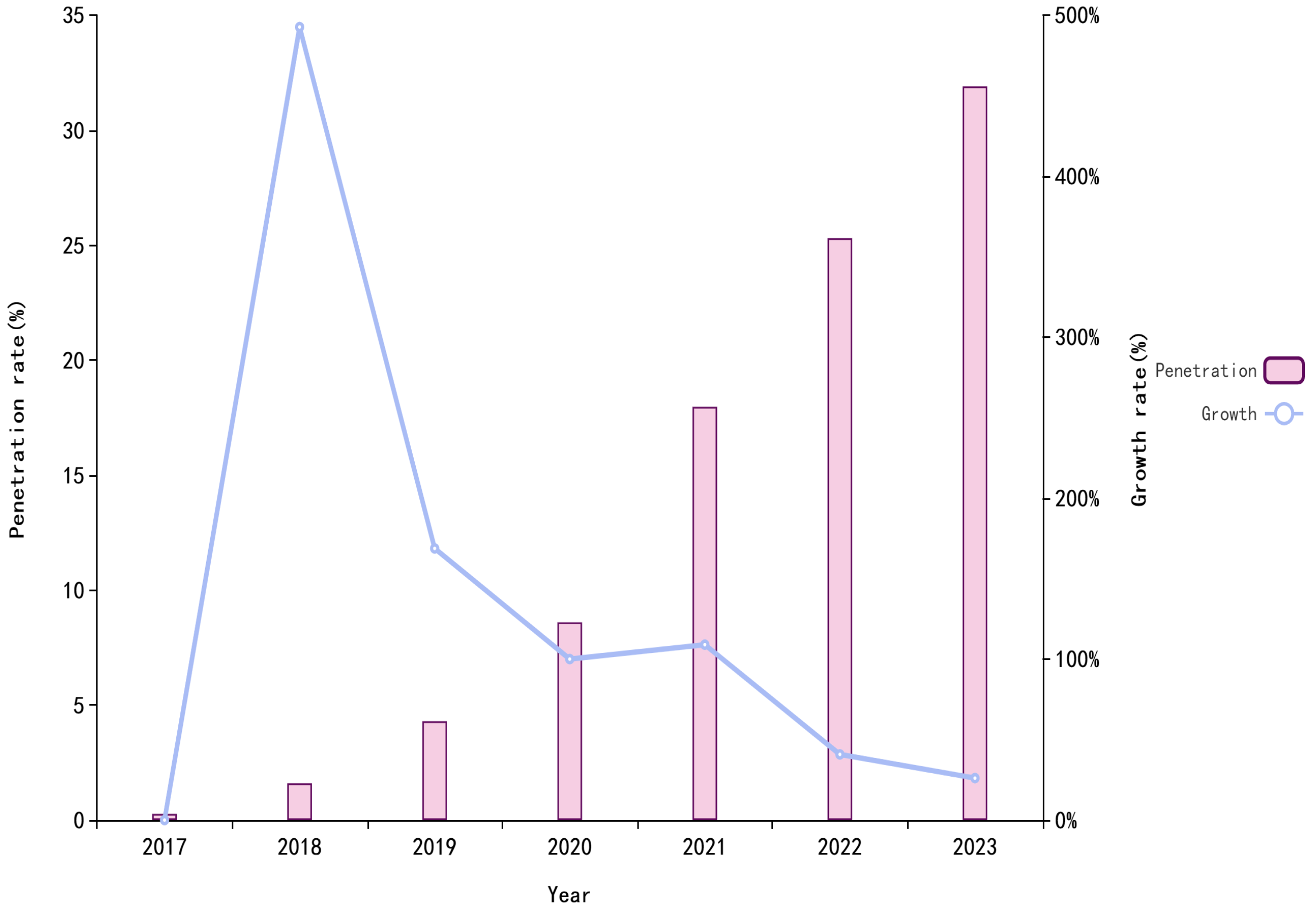
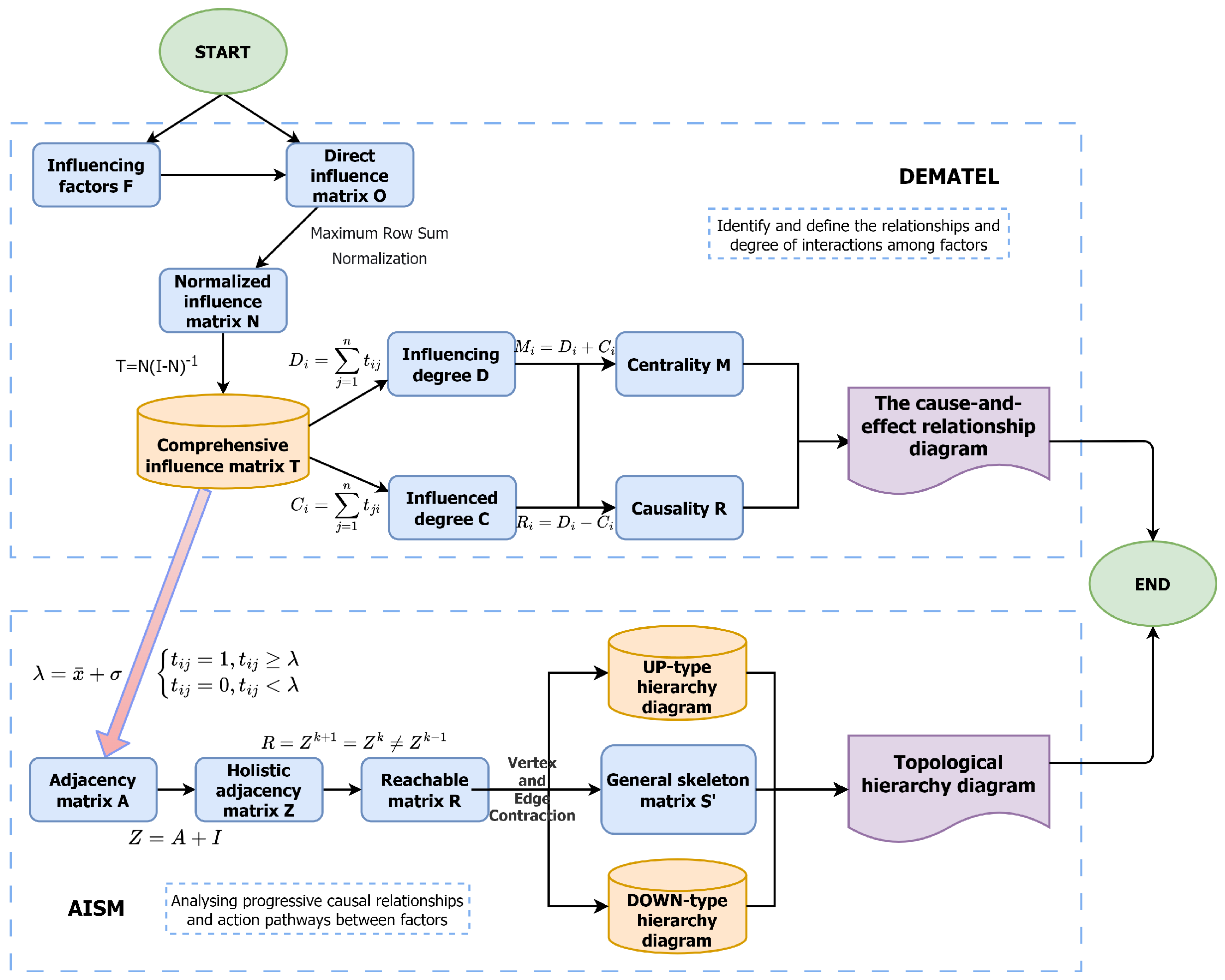
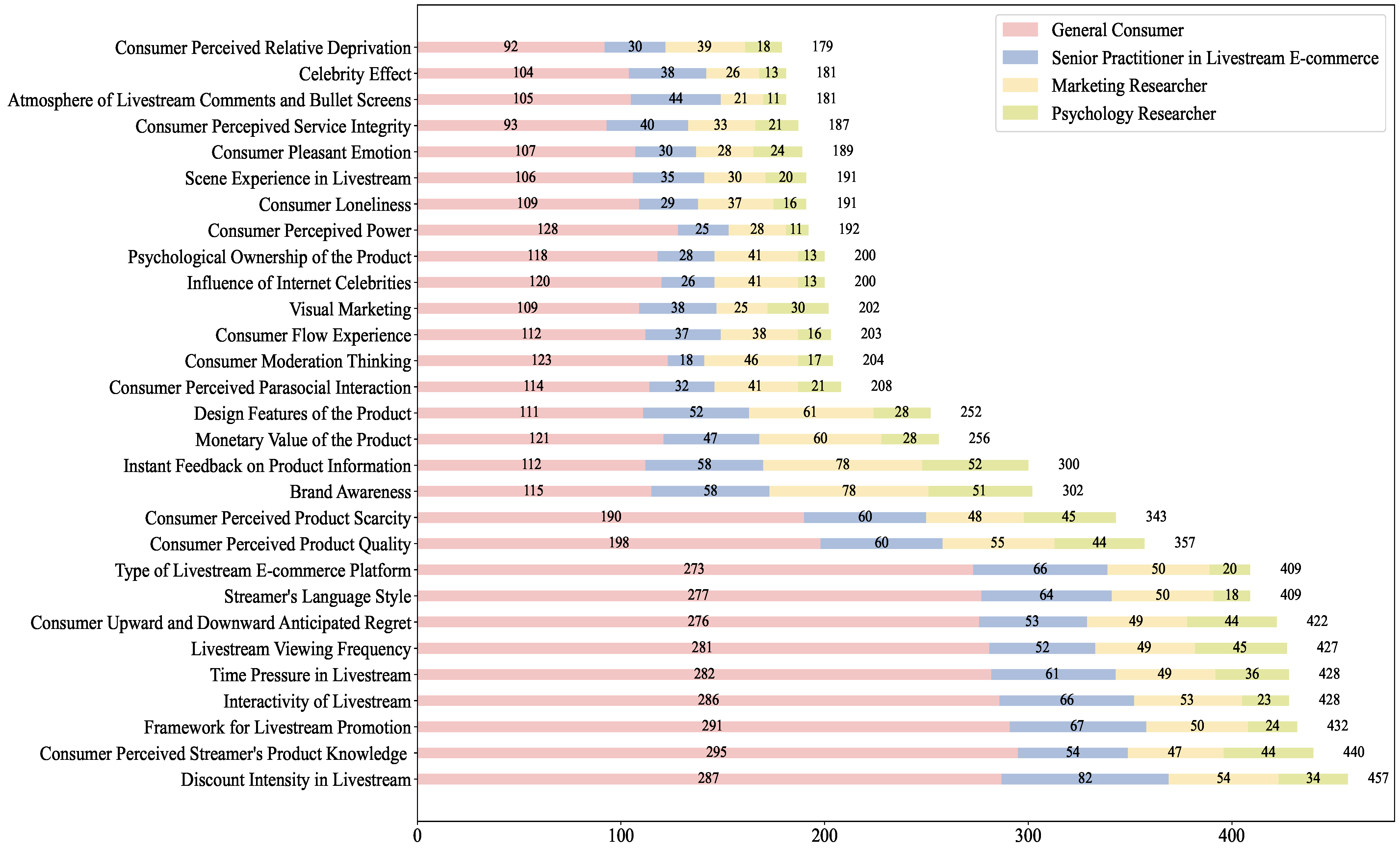
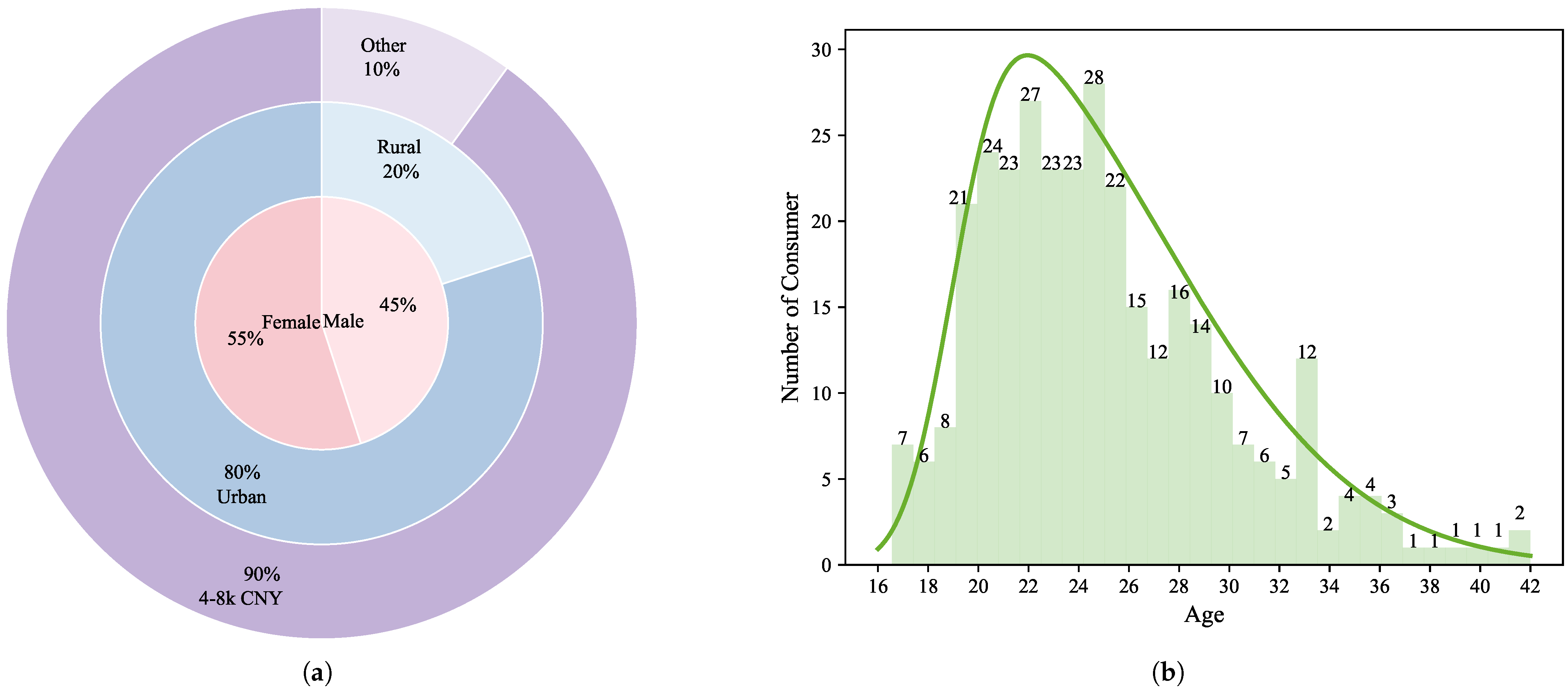

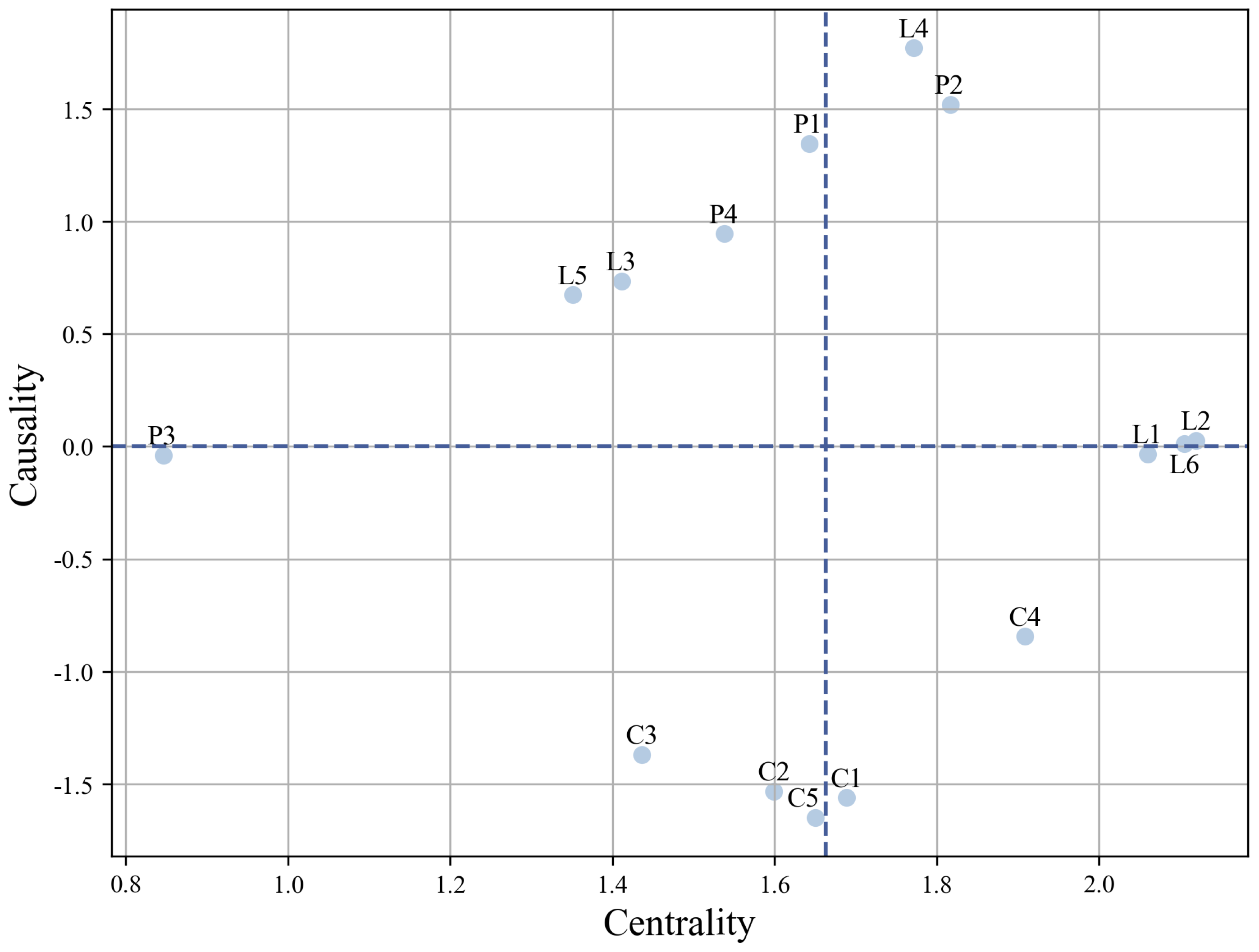
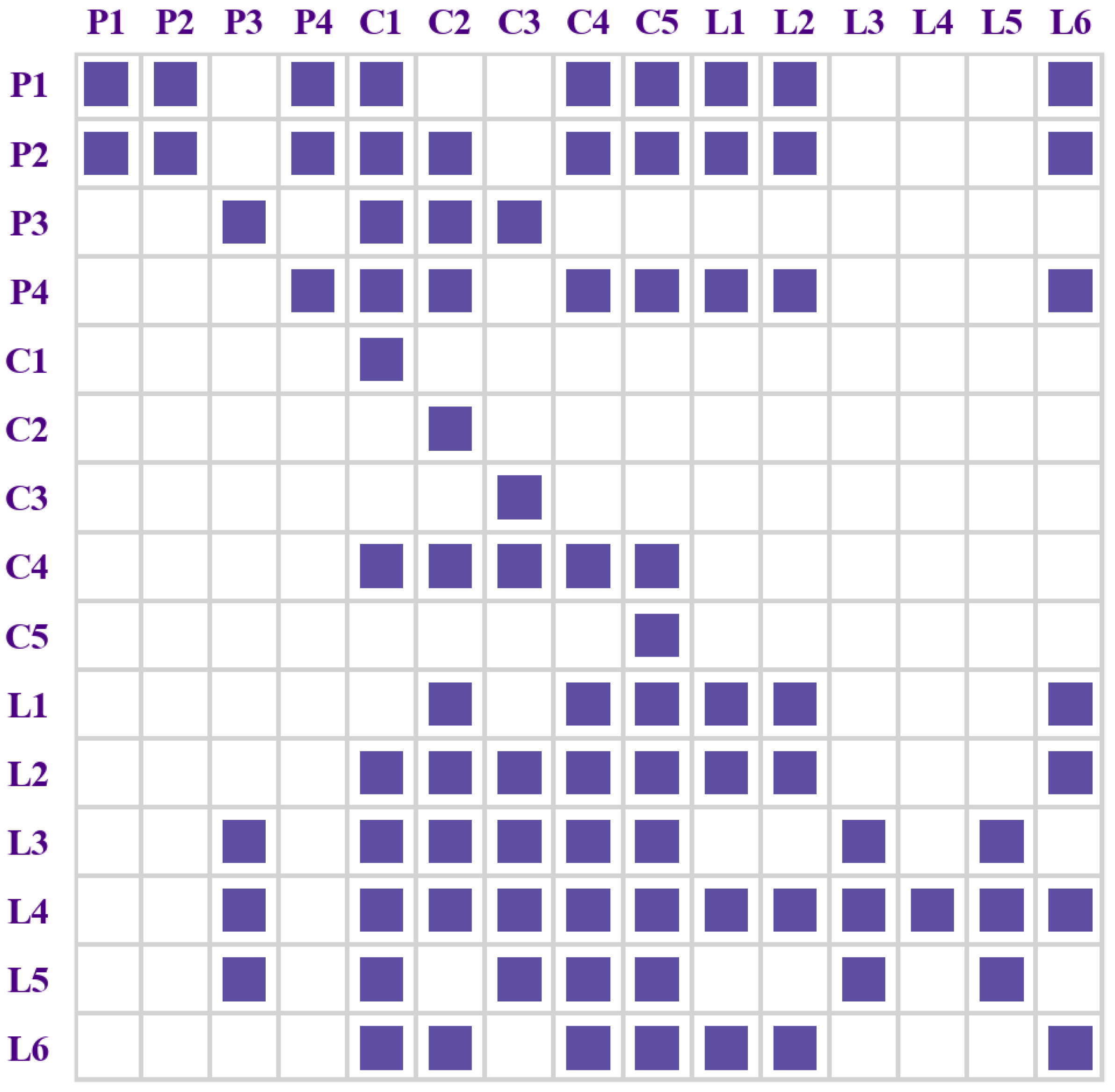
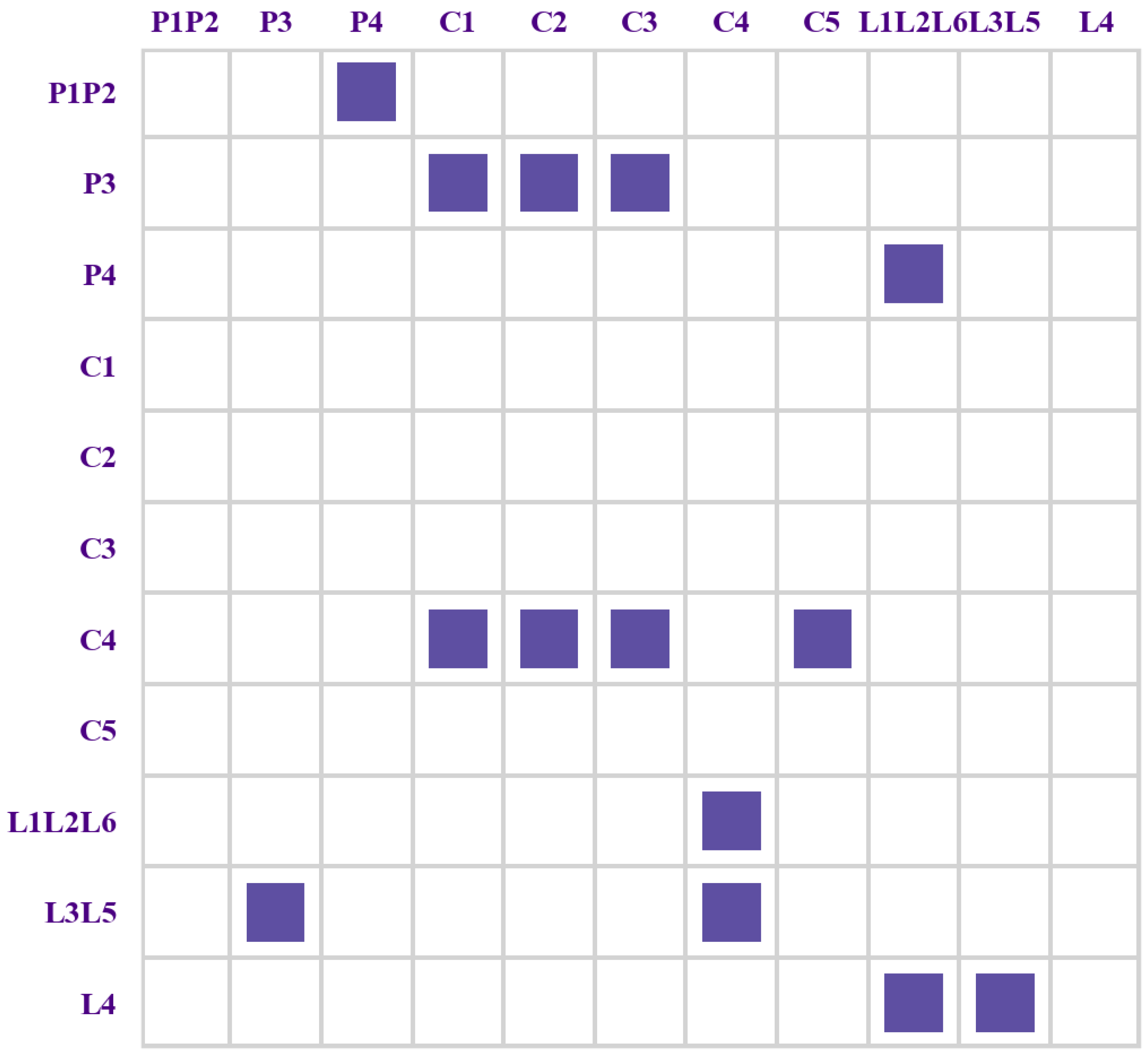
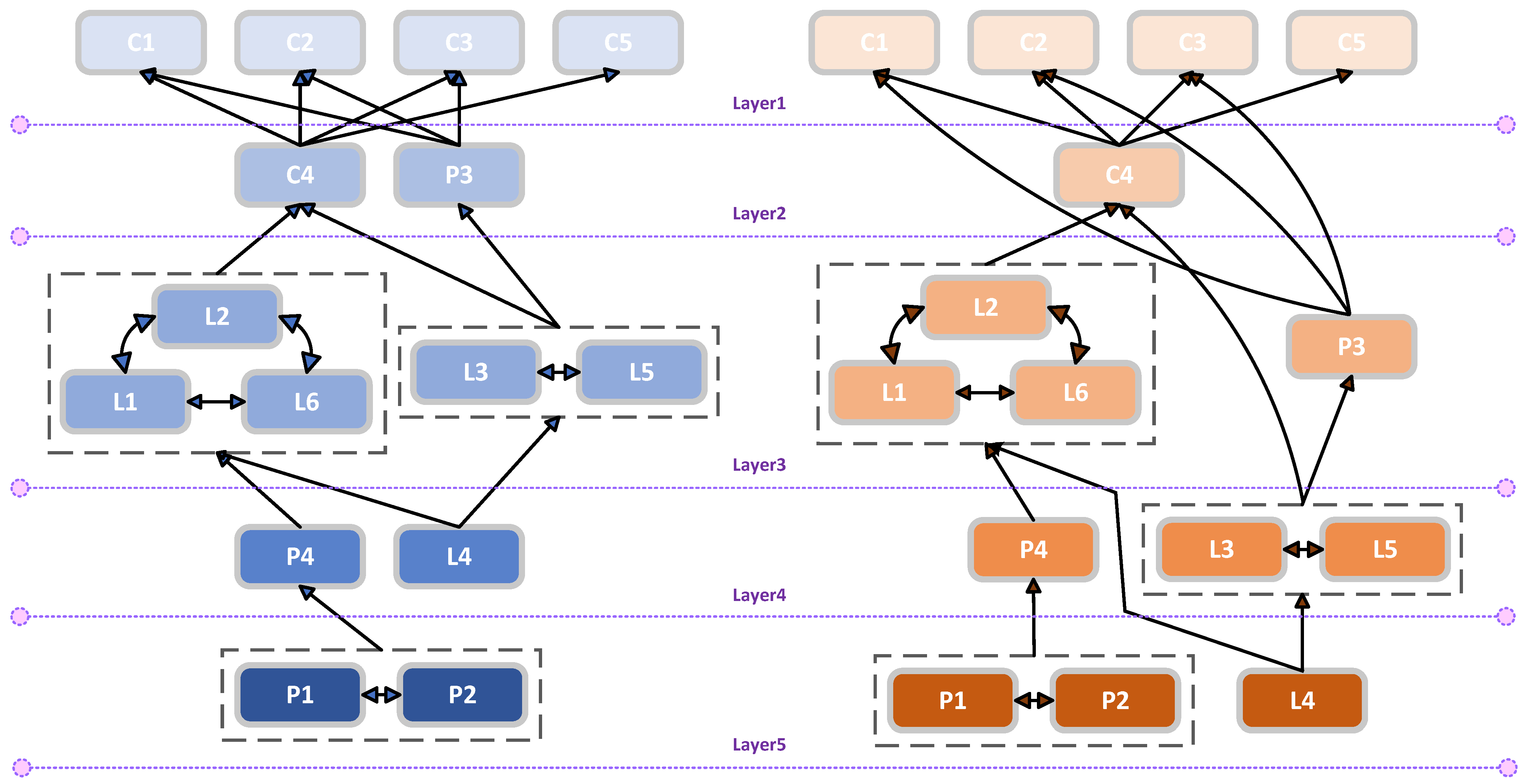
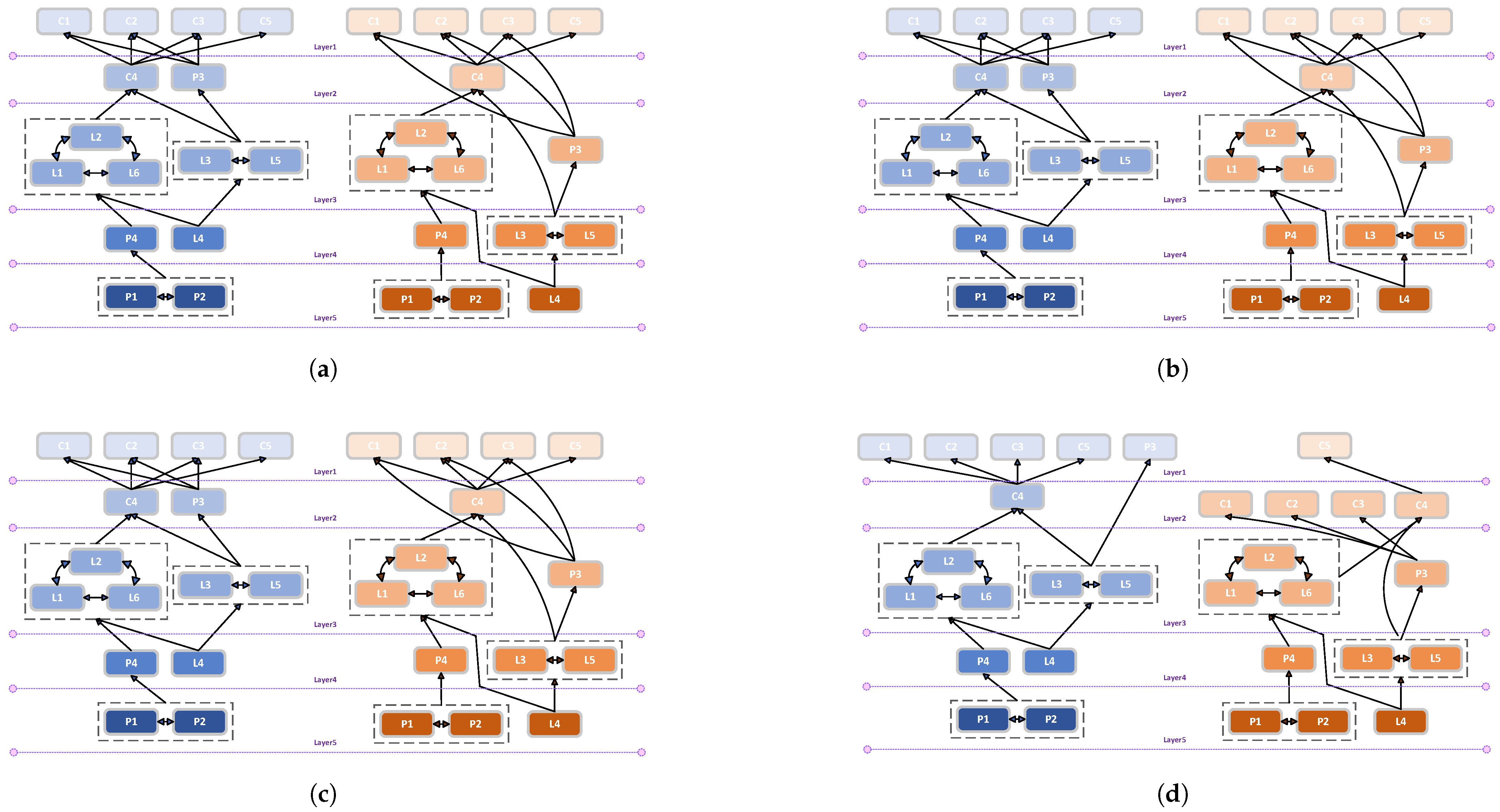

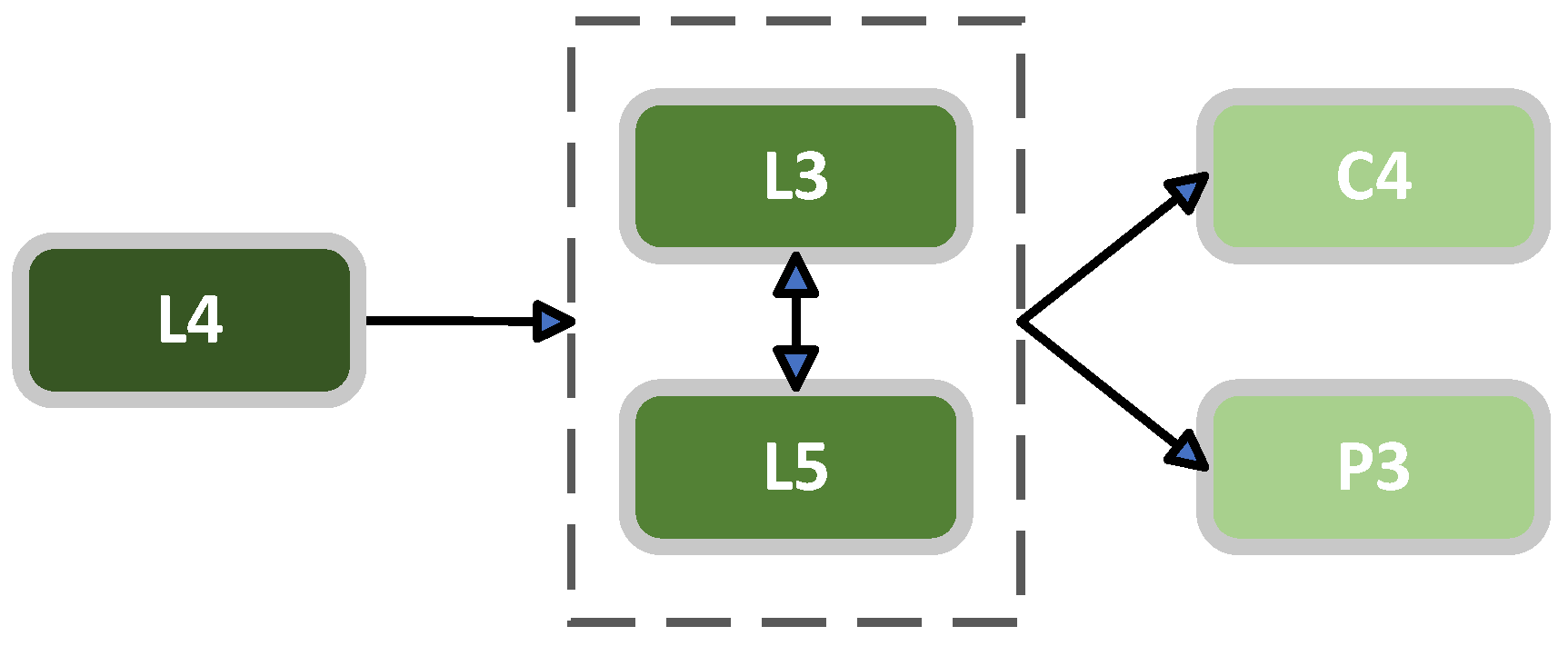
| Method | Key Feature | Limitations | Applicability |
|---|---|---|---|
| S-O-R Theory | Focuses on stimuli affecting consumer behavior | Limited in modeling interactions | Basic consumer behavior analysis |
| SEM | Causal relationships (linear) | Assumes linearity, lacks complexity | Simple causal modeling |
| PLS-SEM | Small samples, non-normal data | Assumes linearity, limited scope | Small sample, simple structures |
| DEMATEL-AISM | Non-linear, hierarchical analysis | Computationally intensive (with partial order rules) | Complex systems, nonlinear interactions |
| Level | Level 1 | Level 2 | Level 3 | Level 4 | Level 5 |
|---|---|---|---|---|---|
| Influence degree | No influence | Low | Medium | High | Significant |
| Numerical scale | 0 | 1 | 2 | 3 | 4 |
| Perspective | Variable | Factor | Definition | Sources |
|---|---|---|---|---|
| Product | P1 | Monetary Value of the Product | The ratio between the utility of a product and its value that consumers compare one with different products from the perspective of benefits and costs. A higher monetary value indicates a greater monetary advantage over other alternatives. | [65] |
| P2 | Design Features of the Product | The ability of the product to achieve its intended purpose. | [45,66,67] | |
| P3 | Instant Feedback on Product Information | The immediacy of various information feedback about the product to consumers from the streamers, other users in the same livestream, customer service employees, etc. | [47] | |
| P4 | Brand Awareness | The level of awareness, understanding, and popularity of the product brand among consumers. | [46,68] | |
| Customer | C1 | Consumer Perceived Product Quality | Consumers’ subjective perception or judgment of the overall excellence and functionality of the product through the livestream. | [29,30] |
| C2 | Consumer Perceived Product Scarcity | The degree to which consumers perceive a lack of or difficulty in obtaining a product or service within a certain period through the livestream. | [19,69] | |
| C3 | Consumer Perceived Streamer’s Product Knowledge | Consumers’ subjective perceived the profundity of knowledge based on the streamers’ language, gestures, etc. | [47,52] | |
| C4 | Livestream Viewing Frequency | The frequency with which consumers watch livestream over a period of time. | [19] | |
| C5 | Consumer Upward and Downward Anticipated Regret | Hesitation and doubt from worry about potential losses before making purchase decisions in livestream. | [49,70] | |
| Livestream | L1 | Time Pressure in Livestream | Objective time limits set by livestream for promotional activities. Perceived opportunity cost, referring to the anxiety and comparative judgment of benefits and expenses that consumers experience when they need to make decisions within a limited time in livestream. | [26,48,71] |
| L2 | Discount Intensity in Livestream | The ratio of the total value of consumer expenditure to the product or service received when the livestream products are discounted directly from their original price, or when promoted through gifts, points, etc. | [25] | |
| L3 | Streamer’s Language Style | The streamer’s linguistic affinity and persuasiveness. The streamer’s ability to convey emotions and Regulating Ability. The fluency of streamer’s language, pace and tone, clarity, and conciseness. Mainly divided into three types: task-oriented, interaction-oriented, and self-oriented. | [72,73,74,75] | |
| L4 | Type of Livestream E-commerce Platform | Platform types which are divided into traditional e-commerce (integrating livestream function based on e-commerce ecosystem, such as Taobao, JD, etc.) and entertainment content (entertainment platforms commercialize through livestream, such as Douyin Live etc.) | [27,28] | |
| L5 | Interactivity of Livestream | The streamer’s ability to establish empathy with audiences by showing aspects of real life. The streamer’s ability to adjust communication style or body language based on perceived audience presence. | [76,77,78,79] | |
| L6 | Framework for Livestream Promotion | Promotion framework which is divided into incentives directly related to money (discounts, rebates, returns, etc.) and incentives indirectly related to money (gifts, giveaways, and point returns, etc.) | [52,80,81] |
| P1 | P2 | P3 | P4 | C1 | C2 | C3 | C4 | C5 | L1 | L2 | L3 | L4 | L5 | L6 | |
|---|---|---|---|---|---|---|---|---|---|---|---|---|---|---|---|
| 1.495 | 1.669 | 0.404 | 1.242 | 0.065 | 0.032 | 0.032 | 0.533 | 0.000 | 1.014 | 1.073 | 1.073 | 1.772 | 1.013 | 1.059 | |
| 0.148 | 0.148 | 0.442 | 0.296 | 0.624 | 1.567 | 1.404 | 1.376 | 1.651 | 1.047 | 1.047 | 0.339 | 0.000 | 0.339 | 1.047 | |
| 1.643 | 1.817 | 0.846 | 1.538 | 1.689 | 1.599 | 1.436 | 1.909 | 1.651 | 2.060 | 2.120 | 1.411 | 1.772 | 1.351 | 2.106 | |
| 1.347 | 1.521 | −0.039 | 0.946 | −1.560 | −1.535 | −1.372 | −0.843 | −1.651 | −0.033 | 0.027 | 0.734 | 1.772 | 0.674 | 0.012 |
| Factors | Reachable Sets R | Cause Sets Q | Common Sets T |
|---|---|---|---|
| P1 | P1, P2, P4, C1, C2, C3, C4, C5, L1, L2, L6 | P1, P2 | P1, P2 |
| P2 | P1, P2, P4, C1, C2, C3, C4, C5, L1, L2, L6 | P1, P2 | P1, P2 |
| P3 | P3, C1, C2, C3 | P3, L3, L4, L5 | P3 |
| P4 | P4, C1, C2, C3, C4, C5, L1, L2, L6 | P1, P2, P4 | P4 |
| C1 | C1 | P1, P2, P3, P4, C1, C4, L1, L2, L3, L4, L5, L6 | C1 |
| C2 | C2 | P1, P2, P3, P4, C2, C4, L1, L2, L3, L4, L5, L6 | C2 |
| C3 | C3 | P1, P2, P3, P4, C3, C4, L1, L2, L3, L4, L5, L6 | C3 |
| C4 | C1, C2, C3, C4, C5 | P1, P2, P4, C4, L1, L2, L3, L4, L5, L6 | C4 |
| C5 | C5 | P1, P2, P4, C4, C5, L1, L2, L3, L4, L5, L6 | C5 |
| L1 | C1, C2, C3, C4, C5, L1, L2, L6 | P1, P2, P4, L1, L2, L3, L4, L5, L6 | L1, L2, L6 |
| L2 | C1, C2, C3, C4, C5, L1, L2, L6 | P1, P2, P4, L1, L2, L3, L4, L5, L6 | L1, L2, L6 |
| L3 | P3, C1, C2, C3, C4, C5, L3, L5 | L3, L4, L5 | L3, L5 |
| L4 | P3, C1, C2, C3, C4, C5, L1, L2, L3, L4, L5, L6 | L4 | L4 |
| L5 | P3, C1, C2, C3, C4, C5, L3, L5 | L3, L4, L5 | L3, L5 |
| L6 | C1, C2, C3, C4, C5, L1, L2, L6 | P1, P2, P4, L1, L2, L3, L4, L5, L6 | L1, L2, L6 |
| Factors | Centrality | Rank by Centrality | Factors | Causality | Absolute Value of Causality | Rank by Absolute Value of Causality |
|---|---|---|---|---|---|---|
| L2 | 2.120 | 1 | L4 | 1.772 | 1.772 | 1 |
| L6 | 2.106 | 2 | C5 | −1.651 | 1.651 | 2 |
| L1 | 2.060 | 3 | C1 | −1.560 | 1.560 | 3 |
| C4 | 1.909 | 4 | C2 | −1.535 | 1.535 | 4 |
| P2 | 1.817 | 5 | P2 | 1.521 | 1.521 | 5 |
| L4 | 1.772 | 6 | C3 | −1.372 | 1.372 | 6 |
| C1 | 1.689 | 7 | P1 | 1.347 | 1.347 | 7 |
| C5 | 1.651 | 8 | P4 | 0.946 | 0.946 | 8 |
| P1 | 1.643 | 9 | C4 | −0.843 | 0.843 | 9 |
| C2 | 1.599 | 10 | L3 | 0.734 | 0.734 | 10 |
| P4 | 1.538 | 11 | L5 | 0.674 | 0.674 | 11 |
| C3 | 1.436 | 12 | P3 | −0.039 | 0.039 | 12 |
| L3 | 1.411 | 13 | L1 | −0.033 | 0.033 | 13 |
| L5 | 1.351 | 14 | L2 | 0.027 | 0.027 | 14 |
| P3 | 0.846 | 15 | L6 | 0.012 | 0.012 | 15 |
Disclaimer/Publisher’s Note: The statements, opinions and data contained in all publications are solely those of the individual author(s) and contributor(s) and not of MDPI and/or the editor(s). MDPI and/or the editor(s) disclaim responsibility for any injury to people or property resulting from any ideas, methods, instructions or products referred to in the content. |
© 2025 by the authors. Licensee MDPI, Basel, Switzerland. This article is an open access article distributed under the terms and conditions of the Creative Commons Attribution (CC BY) license (https://creativecommons.org/licenses/by/4.0/).
Share and Cite
Ma, S.; Wei, W.; Wang, J.; Liu, H.; Song, Y.; Yang, L. Influencing Factors of Consumers’ Impulse Purchase Intentions in Livestream E-Commerce Based on DEMATEL-AISM. J. Theor. Appl. Electron. Commer. Res. 2025, 20, 86. https://doi.org/10.3390/jtaer20020086
Ma S, Wei W, Wang J, Liu H, Song Y, Yang L. Influencing Factors of Consumers’ Impulse Purchase Intentions in Livestream E-Commerce Based on DEMATEL-AISM. Journal of Theoretical and Applied Electronic Commerce Research. 2025; 20(2):86. https://doi.org/10.3390/jtaer20020086
Chicago/Turabian StyleMa, Sijie, Wanjing Wei, Jiahui Wang, Haoyu Liu, Yujie Song, and Lei Yang. 2025. "Influencing Factors of Consumers’ Impulse Purchase Intentions in Livestream E-Commerce Based on DEMATEL-AISM" Journal of Theoretical and Applied Electronic Commerce Research 20, no. 2: 86. https://doi.org/10.3390/jtaer20020086
APA StyleMa, S., Wei, W., Wang, J., Liu, H., Song, Y., & Yang, L. (2025). Influencing Factors of Consumers’ Impulse Purchase Intentions in Livestream E-Commerce Based on DEMATEL-AISM. Journal of Theoretical and Applied Electronic Commerce Research, 20(2), 86. https://doi.org/10.3390/jtaer20020086






